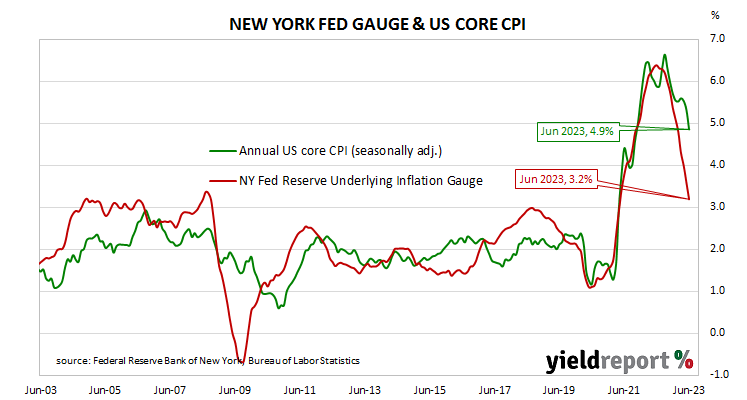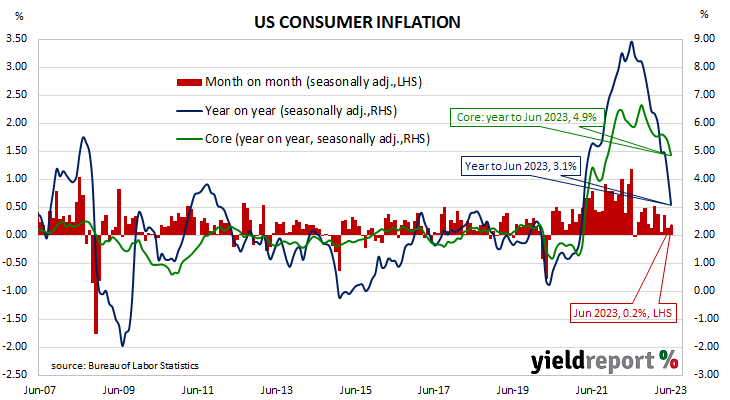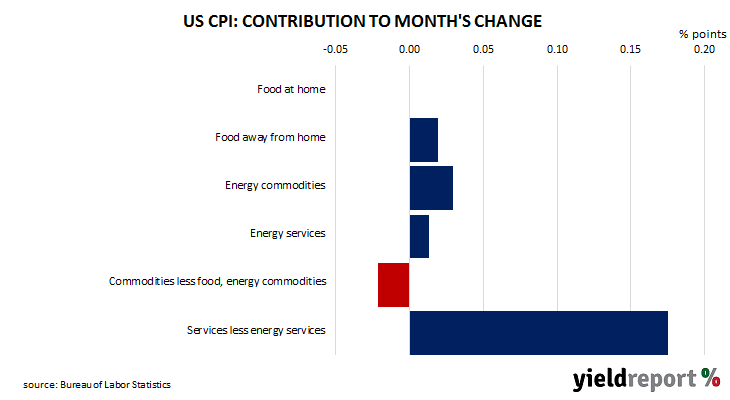Summary: US CPI up 0.2% in June, less than expected; “core” rate up 0.2%; ANZ: confirms clear downtrend in core inflation; Treasury yields fall materially; rate-cut expectations harden; NAB: core result dominated by airfares, travel, used vehicle prices; non-energy services prices again main driver, adds 0.18 ppts.
The annual rate of US inflation as measured by changes in the consumer price index (CPI) halved from nearly 3% in the period from July 2018 to February 2019. It then fluctuated in a range from 1.5% to 2.0% through 2019 before rising above 2.0% in the final months of that year. Substantially lower rates were reported from March 2020 to May 2020 and they remained below 2% until March 2021. Rates have since risen significantly, although they have been declining since mid-2022.
The latest US CPI figures released by the Bureau of Labor Statistics indicated seasonally-adjusted consumer prices also increased by 0.2% on average in June. The result was less than the 0.3% increase which had been generally expected but more than May’s 0.1% rise. On a 12-month basis, the inflation rate slowed from 4.1% to 3.1%.
“Headline” inflation is known to be volatile and so references are often made to “core” inflation for analytical purposes. The core prices index, the index which excludes the more variable food and energy components, increased by 0.2% on a seasonally-adjusted basis over the month. The rise was less than the expected 0.3% increase as well as May’s 0.4% increase and the annual growth rate slowed from 5.3% to 4.9%.
“Overall, the report confirms a clear downtrend in core inflation is evident in the US,” said ANZ economist Madeline Dunk.
US Treasury bond yields fell materially on the day By the close of business, the 2-year Treasury yield had shed 12bps to 4.75%, the 10-year yield had lost 11bps to 3.86% while the 30-year yield finished 6bps lower at 3.95%.
In terms of US Fed policy, expectations of a lower federal funds rate in the first half of 2024 hardened. At the close of business, contracts implied the effective federal funds rate would average 5.11% in July, 3bps more than the current spot rate, and then increase to an average of 5.30% in August. December futures contracts implied a 5.35% average effective federal funds rate while June 2024 contracts implied 4.745%, 33bps less than the current rate.
“The soft print was dominated by a few factors such as airfares, travel and used vehicle prices,” noted NAB Senior Interest Rate Strategist (Markets) Ken Crompton. “The core service ex-rents measure was steady and, annualising at 2.9% for the three months to June, is still running fairly hot. However it’s well down on the 4.8% pace for the annualised three months to March.”
The largest influence on headline results is often the change in fuel prices. Prices of “Energy commodities”, the segment which contains vehicle fuels, increased by 0.8% and contributed 0.03 percentage points to the total. However, prices of non-energy services, the segment which includes actual and implied rents, again had the largest effect on the total, adding 0.18 percentage points after increasing by 0.3% on average.
The Federal Reserve Bank of New York publishes an unofficial estimate of underlying inflation, known as the Underlying Inflation Gauge (UIG) and it was updated shortly after these latest CPI figures. While the Federal Reserve states the UIG does not represent an official estimate, the UIG does appear to lead the core CPI measure. June’s UIG registered an annual rate of 3.2%, down from May’s figure of 3.6%.




